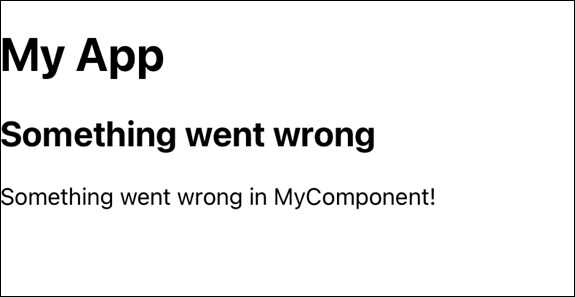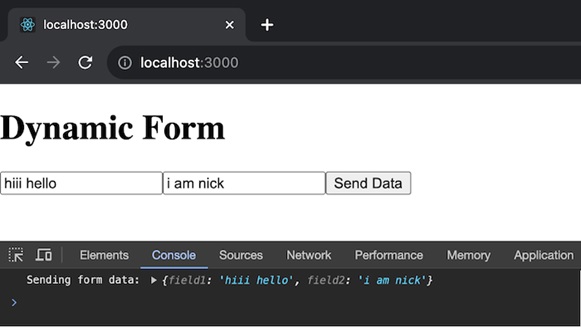
- ReactJS Tutorial
- ReactJS - Home
- ReactJS - Introduction
- ReactJS - Installation
- ReactJS - Features
- ReactJS - Advantages & Disadvantages
- ReactJS - Architecture
- ReactJS - Creating a React Application
- ReactJS - JSX
- ReactJS - Components
- ReactJS - Nested Components
- ReactJS - Using Newly Created Components
- ReactJS - Component Collection
- ReactJS - Styling
- ReactJS - Properties (props)
- ReactJS - Creating Components using Properties
- ReactJS - props Validation
- ReactJS - Constructor
- ReactJS - Component Life Cycle
- ReactJS - Event management
- ReactJS - Creating an Event−Aware Component
- ReactJS - Introduce Events in Expense Manager APP
- ReactJS - State Management
- ReactJS - State Management API
- ReactJS - Stateless Component
- ReactJS - State Management Using React Hooks
- ReactJS - Component Life Cycle Using React Hooks
- ReactJS - Layout Component
- ReactJS - Pagination
- ReactJS - Material UI
- ReactJS - Http client programming
- ReactJS - Form Programming
- ReactJS - Controlled Component
- ReactJS - Uncontrolled Component
- ReactJS - Formik
- ReactJS - Conditional Rendering
- ReactJS - Lists
- ReactJS - Keys
- ReactJS - Routing
- ReactJS - Redux
- ReactJS - Animation
- ReactJS - Bootstrap
- ReactJS - Map
- ReactJS - Table
- ReactJS - Managing State Using Flux
- ReactJS - Testing
- ReactJS - CLI Commands
- ReactJS - Building and Deployment
- ReactJS - Example
- Hooks
- ReactJS - Introduction to Hooks
- ReactJS - Using useState
- ReactJS - Using useEffect
- ReactJS - Using useContext
- ReactJS - Using useRef
- ReactJS - Using useReducer
- ReactJS - Using useCallback
- ReactJS - Using useMemo
- ReactJS - Custom Hooks
- ReactJS Advanced
- ReactJS - Accessibility
- ReactJS - Code Splitting
- ReactJS - Context
- ReactJS - Error Boundaries
- ReactJS - Forwarding Refs
- ReactJS - Fragments
- ReactJS - Higher Order Components
- ReactJS - Integrating With Other Libraries
- ReactJS - Optimizing Performance
- ReactJS - Profiler API
- ReactJS - Portals
- ReactJS - React Without ES6 ECMAScript
- ReactJS - React Without JSX
- ReactJS - Reconciliation
- ReactJS - Refs and the DOM
- ReactJS - Render Props
- ReactJS - Static Type Checking
- ReactJS - Strict Mode
- ReactJS - Web Components
- Additional Concepts
- ReactJS - Date Picker
- ReactJS - Helmet
- ReactJS - Inline Style
- ReactJS - PropTypes
- ReactJS - BrowserRouter
- ReactJS - DOM
- ReactJS - Carousel
- ReactJS - Icons
- ReactJS - Form Components
- ReactJS - Reference API
- ReactJS Useful Resources
- ReactJS - Quick Guide
- ReactJS - Useful Resources
- ReactJS - Discussion
ReactJS - componentDidCatch() Method
React is a popular JavaScript library for creating user interfaces. And while creating the React applications we may face errors in our code. When these errors occur in React components, handling them properly can be a difficult task. This is where the componentDidCatch function can be used. So, componentDidCatch catches errors in our components and prevents our entire app from crashing. So we will see how it works with the help of an example.
What is componentDidCatch?
componentDidCatch is a function that can be defined in React components. Its major function is to detect errors in any of the component's child elements, no matter how deep down the component tree that is located.
When an error happens in any child component, React will call componentDidCatch. It gives us a chance to respond to the error.
One common use of componentDidCatch is to log the error. In production, this can be sent to an error reporting service, allowing us to track and fix issues.
Syntax
componentDidCatch(error, info)
Parameters
There are two parameters used in componentDidCatch function: error and info.
error − This is the error that was thrown. It is commonly an instance of the Error object, but it could also be strings or null.
info − This is data regarding the error. It provides a stack trace that indicates where the issue occurred and which components were involved.
Return Value
The componentDidCatch function does not return anything. It is used mainly to tell errors not to produce results.
How to use it?
We will create an app and use componentDidCatch to show the usage of it −
In this app, we have a MyComponent that knowingly throws an error in its componentDidMount function to get an error. We will use MyComponent in an ErrorBoundary, which will catch and handle any errors that occur in MyComponent. If an error occurs in MyComponent, the ErrorBoundary will display a custom fallback UI with the error message.
Examples
Example
import React from 'react';
class MyComponent extends React.Component {
constructor(props) {
super(props);
this.state = { data: null };
}
componentDidMount() {
// Try to parse invalid JSON to evoke an error.
try {
JSON.parse("This is not valid JSON");
} catch (error) {
throw new Error("Something went wrong in MyComponent!");
}
}
render() {
// Render the component as usual
return <div>{this.state.data}</div>;
}
}
class ErrorBoundary extends React.Component {
constructor(props) {
super(props);
this.state = { hasError: false, error: null };
}
static getDerivedStateFromError(error) {
// Update state to show a fallback UI and store the error
return { hasError: true, error };
}
componentDidCatch(error, info) {
console.error("Error caught by ErrorBoundary:", error);
console.error("Component Stack:", info.componentStack);
}
render() {
if (this.state.hasError) {
// Render a custom fallback UI with the error message
return (
<div>
<h2>Something went wrong</h2>
<p>{this.state.error.message}</p>
</div>
);
}
// Render the child components if no error found
return this.props.children;
}
}
function App() {
return (
<div>
<h1>My App</h1>
<ErrorBoundary>
<MyComponent />
</ErrorBoundary>
</div>
);
}
export default App;
Output

Example − Dynamic Form with Error Handling
This app shows a dynamic form where users can input data into fields. If there is an error during form data processing, the componentDidCatch method logs the error and informs the user about the issue.
import React, { Component } from 'react';
class DynamicForm extends Component {
constructor(props) {
super(props);
this.state = {
formData: {},
hasError: false,
};
}
handleInputChange = (field, value) => {
try {
// Logic to handle dynamic form data
this.setState(prevState => ({
formData: {
...prevState.formData,
[field]: value,
},
}));
} catch (error) {
// Handle errors
this.setState({ hasError: true });
}
};
handleButtonClick = () => {
// Sending form data to a server
try {
// Logic to send data to the server
console.log('Sending form data:', this.state.formData);
} catch (error) {
// Handle errors in sending data
console.error('Error sending form data:', error);
this.setState({ hasError: true });
}
};
componentDidCatch(error, info) {
console.error('Form Error:', error, info);
this.setState({ hasError: true });
}
render() {
if (this.state.hasError) {
return <div>Sorry, there was an issue with the form.</div>;
}
return (
<div>
<h1>Dynamic Form</h1>
<input
type="text"
placeholder="Field 1"
onChange={e => this.handleInputChange('field1', e.target.value)}
/>
<input
type="text"
placeholder="Field 2"
onChange={e => this.handleInputChange('field2', e.target.value)}
/>
<button onClick={this.handleButtonClick}>Send Data</button>
</div>
);
}
}
export default DynamicForm;
Output

When the user clicks the "Send Data" button, the form data will be logged to the console. We can replace the console.log statement in the handleButtonClick method with our actual logic for sending data to the server using fetch.
Notes
In the past, developers used setState inside componentDidCatch to change the user interface and display error warnings. This method is now considered outdated. For handling errors, it is better to use static getDerivedStateFromError.
In development and production, React behaves differently. In development, componentDidCatch will catch errors and send them to the browser's global error handlers. They will not bubble up in production, so we must explicitly catch them with componentDidCatch.
Summary
componentDidCatch is a helpful React feature that allows us to manage errors in our components properly. It is like having a safety net that records errors and allows us to log them or display error messages. Just keep in mind that it should be used in combination with getDerivedStateFromError and that there are changes between development and production settings.
To Continue Learning Please Login